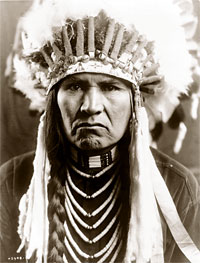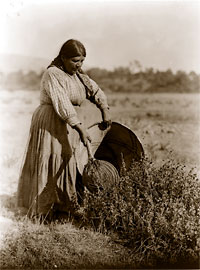Edward Curtis’ The North American Indian
The million-dollar set of photographs plunged its creator into debt and obscurity By Jonathan ShipleyJonathan Shipley is a freelance writer living in Seattle with his young daughter. He’s been published in the LA Times, Boston Globe, Diner Journal, and many other publications.
Once, along the shores of Seattle, Washington, a young man met an old princess. She, out from her waterfront cabin, was on the tideflats collecting clams and mussels. He stopped her and asked if he could take a photograph. He had a burgeoning photography studio in the growing city. He would pay her, he said, a dollar a picture. She had been taking in laundry and selling hand-woven baskets on street corners for money, so she was delighted at the prospect. They both readily agreed to the deal.
It was 1895, and it was then that Edward Sheriff Curtis took his first portraits of a Native American. The princess was Kikisoblu, the eldest daughter of Chief Sealth, for whom Seattle is named. Called Princess Angeline by the city dwellers, she was Curtis’ first portrait of an Indian. Little did he realize how profound those first images would become. Almost his entire working life from that point forward would be focused on documenting the Native Americans, leading to the creation of The North American Indian, a twenty-volume series of photographs and ethnographic descriptions of Native American tribes west of the Mississippi River.
The tribal ways of life, Curtis believed, were quickly vanishing. For decades he toiled on the project, far surpassing his initial five-year estimate. From the striking prairies of Montana to the merciless heat of Arizona, from the rainy forests of Oregon to the frigid taiga of Alaska, Curtis took photos, wrote, and did his best to document the Indians—all of them, he hoped. It would cost him his health, his marriage, and his financial stability to do it. Along the way, though, he met Theodore Roosevelt, J. P. Morgan, and Cecil B. DeMille. More importantly, he met the men and women who would have been lost to the mists of time had it not been for his photographs. People like Big Knife, Fish Shows, Piopo-Maksmaks, Iron Breast, Yellow Owl, Eagle Child, Crazy Thunder, Morning Flower, and countless others.
Today, The North American Indian masterwork mainly resides in institutions, libraries, and the private collections of the wealthy. Only a few hundred sets were actually printed, and complete sets at auction are rare. In 2005 a complete set sold for $1.4 million, and two years later, a less-than-complete set was hammered down just under the million mark. Lois Flury, of Flury and Company in Seattle, made a private sale of a full set for $1.8 million. Bruce Kapson, of Bruce Kapson Gallery in California, currently has on his website one volume with a price tag of $14,500. Christopher Cardozo, of Christopher Cardozo Fine Art, features “Zuni Governor” on his website for $21,450. Depending on the volume, condition, and type of paper, Flury estimated a single volume from the set can run anywhere between $12,000 and $50,000 with folios ranging from $25,000 to $150,000.
Curtis himself never saw any one of those substantial sums for his lifelong efforts. In fact, he died in relative obscurity with little to call his own. The New York Times ran a small obituary upon his death on October 19, 1952. It was less than one hundred words long and noted—as a brief aside—“Mr. Curtis was also known as a photographer.”
According to Lois Flury, who has studied and collected Curtis since the 1970s, “He was a man of tremendous talent and vision. He refused to give up. He never quit. He knew there would be challenges but it wasn’t in his vocabulary to say, ‘I failed.’”









